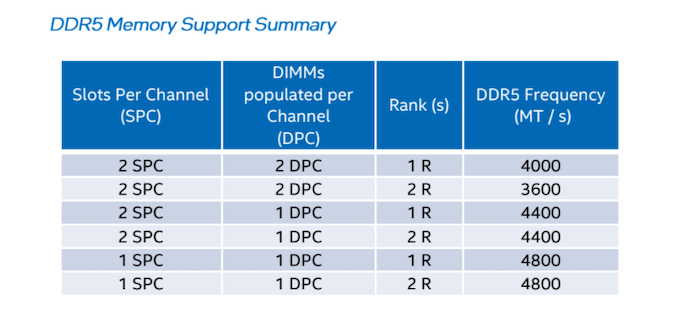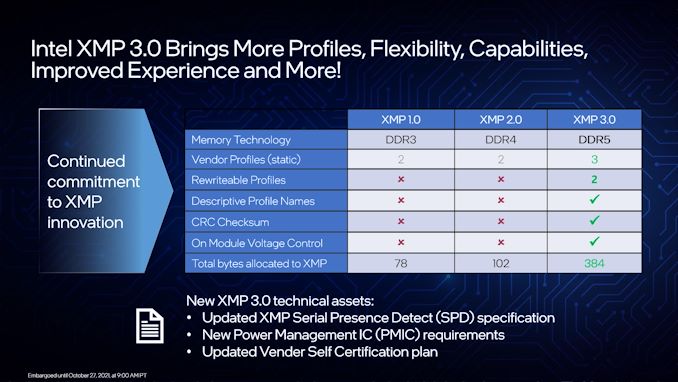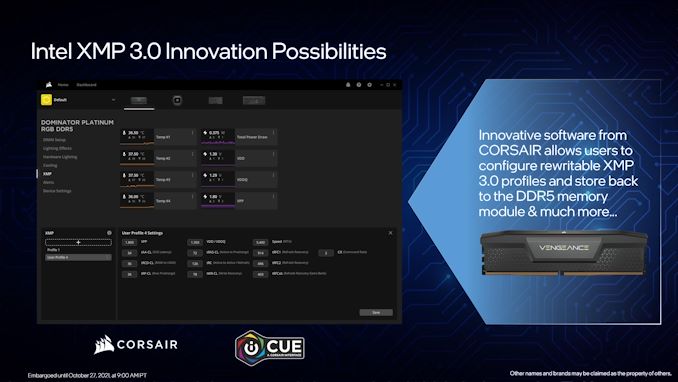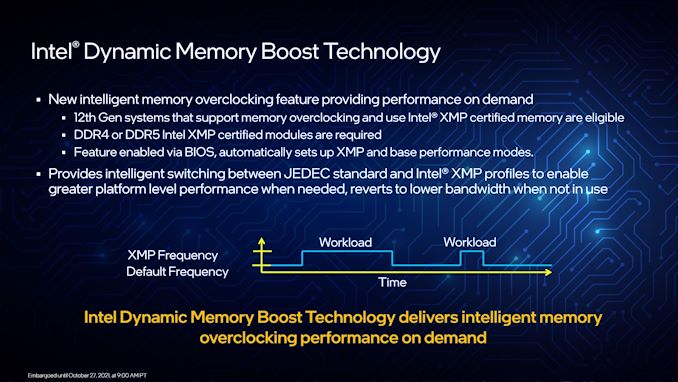Intel 12th Gen Core Alder Lake for Desktops: Top SKUs Only, Coming November 4th
by Dr. Ian Cutress on October 27, 2021 12:00 PM EST- Posted in
- CPUs
- Intel
- DDR4
- DDR5
- PCIe 5.0
- Alder Lake
- Intel 7
- 12th Gen Core
- Z690
Memory: Varies with Number of Modules
Inside each of the Alder Lake processors are memory controllers for both DDR5 and DDR4. Unlike previous generations, we’re unlikely to see motherboards supporting both types of memory. We understand that Intel has explicitly requested this – we didn’t see many retail combo boards in the DDR3/DDR4 era, so expect to see fewer this time around (although you can imagine someone will eventually do it). There is a slight technical reason too – DDR5 uses onboard power management, while DDR4 requires that from the motherboard, something which is hard to implement without wholly independent traces for both. If Intel is saying both cannot be done at the same time, then it’s likely that this is a unified DDR4+DDR5 controller that shares an amount of logic internally, but only one can be used at any one time.
Intel lists the specifications for its memory support as DDR4-3200 and DDR5-4800, and as always memory support is listed as conforming to the JEDEC implementations. This means Intel qualifies DDR4-3200 CL22, and anything above that is technically overclocking the CPU – it’s actually hard to find consumer memory at this speed these days. For DDR5, there are actually three specifications here:
| DDR5 JEDEC Specifications | |||||||
| AnandTech | Data Rate MT/s |
CL |
Peak BW GB/s |
Latency (ns) |
|||
| DDR5-4800 | A | 4800 | 34 | 34 | 34 | 38.40 | 14.17 |
| B | 40 | 40 | 40 | 16.67 | |||
| C | 42 | 42 | 42 | 17.50 | |||
We clarified with Intel that the processor supports all three, with the top being DDR5-4800A CL34. This is despite Intel shipping DDR5-4800B CL40 with their press kits, but I digress.
The thing with memory support is that it usually quoted for a specific number of modules installed into the system. In this case, Intel is quoting these numbers using one module per channel (technically a 64-bit channel, but more on that later), meaning that these are the supported speeds when two memory modules are supported. The official supported speed changes if you have more memory, double-sided memory, or dual rank memory.
We’ve seen this before – server processors are notorious for having slower support when more memory modules are installed. It turns out the more bandwidth you need, the harder it is to keep that speed with higher capacity memory. It was only until Intel’s 11th Gen Core products that the memory design supported DDR4-3200 regardless of configuration, because sometimes that’s how long it takes to optimize a memory controller. For Alder Lake, DDR4-3200 is also supported in any configuration, but DDR5 changes depending on the memory.
Intel shared this table with us.
If the motherboard has two memory slots total, then the maximum support is DDR5-4800 in any configuration.
If the motherboard has four memory slots total, then the maximum support is DDR5-4400 when two slots are filled with any memory.
If all four memory slots are filled, single rank memory will support up to DDR5-4000.
If all four memory slots are filled, dual-rank memory will support up to DDR5-3600.
So technically Intel listing memory support on Alder Lake as DDR5-4800 is a bit of a misdirection compared to previous launches. If we were to look at parity, two modules in a four-slot board, then really we’d be quoting DDR5-4400. Funnily enough, all of Intel’s benchmarks presented at this launch were run at DDR5-4400, as per specification. Kudos to the testing team to staying within those guidelines.
A side note here on memory channels as a whole. In the desktop space, we’re used to one memory module having memory for one 64-bit memory channel. That’s true for DDR4, DDR3, DDR2 etc, but the DDR5 specifications move to 32-bit memory channels. So while each DDR5 module is still using 64-bits of bandwidth, there are technically two 32-bit memory channels worth of memory on each module. This can create a little bit of confusion, because it means that Intel 12th Gen, while still a 128-bit memory interface as previous generations, it uses 4x 32-bit channels, not 2x 64-bit. Undoubtedly companies (even Intel) still call this dual-channel, as a channel is usually inferred to be a 64-bit interface.
There is no easy solution here. 2DPC (two modules per channel) doesn’t really mean much if technically channel there infers 64-bit but you’re running on a 2x32-bit channel system. Some users are calling a DDR5 module a ’channel’ with two 32-bit ‘sub-channels’, although that is more a twisting of reality, given that sub-channels are often something else in memory design. Because we’ve used the word ‘module’ to imply a 64-bit channel for so long, and because memory can be installed with more than one module per 64-bit channel, it’s actually a mess in English to find not only the correct words but also ones simple enough to not make the situation overly complex. Perhaps it’s time for some new words.
Memory: XMP 3.0 and Better SPD
One of the new features with DDR5 is the expansion of Intel’s eXtreme Memory Profile support. Now moving to XMP 3.0, it increases flexibility for both users and vendors by increasing the number of profiles per module, opening up for customization, and improving the overclocking experience.
Memory vendors when they ship the memory will embed in the memory firmware a series of specifications, known as SPDs. For standard memory running to JEDEC specifications, the module will likely contain SPD profiles relating to something slow for underlying support, and then up to what the memory chips were sold at – depending on the motherboard, the system then picks the JEDEC SPD profile that best fits the processor (I’ve seen a wild variety of implementation here, funnily enough.
XMP goes above and beyond traditional SPD support.
XMP 2.0 on DDR4 contains up to two additional SPD profiles with overclocked values. For example, a DDR4-4000 CL16 memory module might have three profiles total – one at 2133 CL15, one at 3200 CL22, and a third XMP profile at 4000 CL16. It is up to the user to then select that profile when in the BIOS or through additional software. If the module has two XMP profiles, perhaps one for latency and another for bandwidth, then this can be done in XMP 2.0.
The update to XMP 3.0 allows for five profiles, rather than two. Three of these profiles are memory module vendor locked, limited by whatever they come out of the factory at. The final two profiles can be used by the memory module vendor, but are re-writable by users in order to save overclocking settings. These profiles can also be named to be descriptive.
Intel states that this re-writing process is backed by a rigorous checksum support so users can’t brick their hardware. For most situations, that’s going to be reasonable, however if that security does get broken, it might be advised that if you buy second-hand DDR5 to erase those profiles and not use them. Just in case it overvolts the memory controller to 3 volts, or something.
Alongside more profiles, because DDR5 moves the power management for the module onto the module itself, if a memory vendor uses a ‘better than base’ solution then users can adjust various voltages and timings on a per-module basis.
Both the profile expansion and the updated voltage controls are also now exposed to the operating system in such a way that allows for better software implementation. Users with Corsair memory, for example, can use Corsair software to adjust the memory on the fly and monitor temperatures, power, voltages, and also keep track of how they fluctuate during overclocking, testing, or normal use. There is also another new feature, allowing users to adjust memory frequency on the fly, which has never been seen before. We’ll cover that in the next section.
On a more ecosystem level, we confirmed with Intel that XMP 3.0 is a self-certification procedure at memory vendors, with no additional licensing costs to the vendors.
Memory Gets Turbo: Dynamic Memory Boost
One of the persistent features with memory over the years is that when you have settings saved in the BIOS, they are ‘trained’ (tested to work) when the system boots up, and then that’s what you have for the whole time that the system is turned on. It never slows down, it never duty cycles to reduce power – it has been very consistent for a long time.
With Intel’s Z690 boards and 12th Gen Core Alder Lake processors, that changes. Much like processors and graphics have had idle states and turbo states for generations, memory now gets it as well.
This first-generation technology is basic, but a start. A 12th Gen system, as long as it runs DDR4 or DDR5 memory with XMP, can define two of the onboard SPD profiles – one as the base, and one as the turbo. Usually the base profile is one of the immutable JEDEC profiles, and the turbo is an XMP profile. But when activated, the system is able to switch on the fly between the two, activating when a workload is initiated for higher performance, and supposedly better idle efficiency.
There are a few thoughts or questions on this worth noting:
#1: It works on DDR4? Intel says yes. This makes it sound like this is more of a software/firmware innovation than a hardware innovation, or it requires the right hardware on the CPU at least. No doubt if it works, it will become ubiquitous.
#2: Isn’t power efficiency really for benchmarks and laptops? I agree with this one, and expect it to be more of a highlighted feature when Alder Lake comes to laptops and notebooks. That being said, most notebook DRAM is JEDEC anyway, so it might open the doors for better-overclocked notebook memory if it can retain the battery life of a base JEDEC profile. Either that, or notebook memory will use a fast JEDEC profile in operation, then move to a more efficient but slower JEDEC profile on idle to save power.
#3: Doesn’t this introduce instability? Perhaps, but if it’s handled in the same way CPU turbo can be, then it shouldn’t be an issue.
In the same way we look to measure how CPU frequency ramps up from a performance request, we will have to look into tools to measure the same thing on memory, especially if more than a simple base/turbo system is developed for future use.














395 Comments
View All Comments
lmcd - Wednesday, October 27, 2021 - link
You don't remember correctly at all. Apple's little cores are stupidly fast for little cores. Andrei flails in every Apple SoC review how stupid it is that there's no ARM licensed core answer to Apple's little cores.Intel probably roadmapped Alder Lake the minute they saw how performant Apple little cores were in even the iPhone 6S.
Atom has been surprisingly good for a while. No need to make up conspiracies when you can buy a Jasper Lake SKU that confirms Intel Atom is far from slow.
name99 - Thursday, October 28, 2021 - link
Apple's small cores are- about 1/3 the performance at
- about 1/0th the power, net result being
- same amount of computation takes about 1/3 the energy.
The Intel cores appear (based on what's claimed) to be substantially faster -- BUT at the cost of substantially more power and thus net energy.
If they are 70% of a P core but also use 70% of the power, that's net equal energy! No win!
It won't be that bad, but if it's something like 70% of a P core at 35% of the power, that's still only half the net energy. Adequate, but not as good as Apple. My guess is we won't get as good as that, we'll land up at something like 50% of the power, so net 70% of the energy of a P core.
(And of course you have to be honest in the accounting. Apple integrates the NoC speed, cache speeds, DRAM speed all ramped up or down in tandem with demand, so that if you're running only E cores it's your entire energy footprint that's reduced to a third. Will Intel drop the E-*core* energy quite a bit, but it makes no real difference because everything from the NoC to the L3 to the DRAM to the PCIe is burning just as much power as before?)
Essentially Apple is optimizing for energy usage by the small cores, whereas Intel seems to be optimizing for something like "performance per area".
That's not an utterly insane design point, but it's also not clear that it's a *great* design point. In essence, it keeps Intel on the same track as the past ten years or so -- prioritizing revenue issues over performance (broadly defined, to include things like energy and new functionality). And so it keeps Intel on track with the Intel faithful -- but does nothing to expand into new markets, or to persuade those who are close to giving up on Intel.
Or to put it more bluntly, it allows Intel to ship a box that scores higher in Cinebench-MT at the same chip area -- but that's unlikely to provide an notably different, "wow", experience from its predecessor, either in energy use or "normal" (ie not highly-threaded) apps.
Of course we'll see when the Anandtech review comes out. But this is what it looks like to me, as the salient difference between how Apple (and, just not as well, ARM) think of big vs little, compared to Intel.
nandnandnand - Thursday, October 28, 2021 - link
"It won't be that bad, but if it's something like 70% of a P core at 35% of the power, that's still only half the net energy."I don't know how it will compare to Apple, but if it has a performance-per-area *and* a performance-per-watt advantage, it is a major improvement for x86. Especially as Intel iterates and puts 16 or 32 E-cores alongside 8 P-cores.
Basically, Intel can continue to tinker with the P-cores to get the best possible single-threaded performance, knowing that 8 P-cores is enough for anyone™, but spamming many E-cores is Intel's path to more multi-threaded performance.
Alder Lake can be considered a beta test. The benefits will really be felt when we see 40 cores, 48 threads (8+32) at the die space equivalent of 16 P-cores. The next node shrink after "Intel 7" will help keep power under control.
vogonpoetry - Wednesday, October 27, 2021 - link
User-rewritable SPDs are a total game-changer for RAM overclockers. Many times I have wished for such a feature. As is on-the-fly power/frequency adjustment (though I wish we could change timings too).As for "Dynamic Memory Boost", doesnt Power Down Mode already do something similar currently? My DDR4 laptop memory frequency can be seen changing depending on workload.
Oxford Guy - Thursday, October 28, 2021 - link
All overclocking is dead.Oxford Guy - Thursday, October 28, 2021 - link
I should have said: 'All user overclocking is dead'.Vendor-approved overclocking (i.e. going beyond JEDEC) is another matter.
Silver5urfer - Wednesday, October 27, 2021 - link
On paper it looks okay. Staring with the Z690 chipset is a really deserved upgrade, lot of I/O plus RAID mode optimizations. AMD RAID is so bad, Level1Techs also showed how awful it was.STIM is interesting, given how 10900K and 11900K improved vastly with Delidding and LM. So that's a plus. Then the whole Win11 BS is annoying garbage. The WIn11 OS is horrible anti user anti desktop anti computing it reeks desperation to imitate Apple as an Ape. It looks ugly, has Win32 downgrades with integration to UWP, Taskbar downgrades, Awful explorer UI. It's outright unacceptable.
Now the big part CPU and Price - Looks like Intel is pricing it wayy lower than AMD. For unknown reasons as Intel never does it, I find it disrupting. Also the CPU OC features are somewhat okay I was expecting lower clocks but looks like 5.1GHz but looking that the new PL1 system I do not have a problem at all since I want full performance now no more BS by GN and etc citing omg the power limits 125W must be kept on a damn K unlocked processor. But there were rumors on power consumption going past 350W like RKL once OCed that's the reason why Intel is going 8C max unlike Sapphire Rapids Xeon at 14C. DDR5 is also on it's new life not worth investing money into the DDR5 new adopter tax if DDR4 works which is what I'm curious about RKL Gear 1 4000Mhz is impossible. I wonder how this will fare.
The leaked performance preview shows mediocre improvements, the ST is definitely a lead on the P cores, real cores. But the SMT / HT is really what I'm interested vs 10900K and Ryzen 5900X. RKL is also fast in ST but SMT was okay not great because 14nm backport.
I'll be waiting to see how Intel executes this, not going to invest tbh because new chipset, new CPU design, Win11 and I want to run Windows 7. I'd rather settle for a 10900K on Z590. PCIe SSDs are not much of a value for me, they have no use beyond load times and boot times for my use case, MLC 860 Pro SATA SSD is way better, runs cool, long lasting as well.
Gothmoth - Wednesday, October 27, 2021 - link
people who do raid without a dedicated PCIe RAID controller have no clue anyway.while most focus on performance i am waiting on performance per WATT figures.
vegemeister - Wednesday, October 27, 2021 - link
Hardware RAID is a recipe for weird bugs and data loss, and provides no benefit over software RAID on top of the same controller running as a dumb HBA.Motherboard fake RAID is similarly pointless.
Gigaplex - Thursday, October 28, 2021 - link
I'd rather do mdadm software RAID or use ZFS vs a PCIe RAID controller.